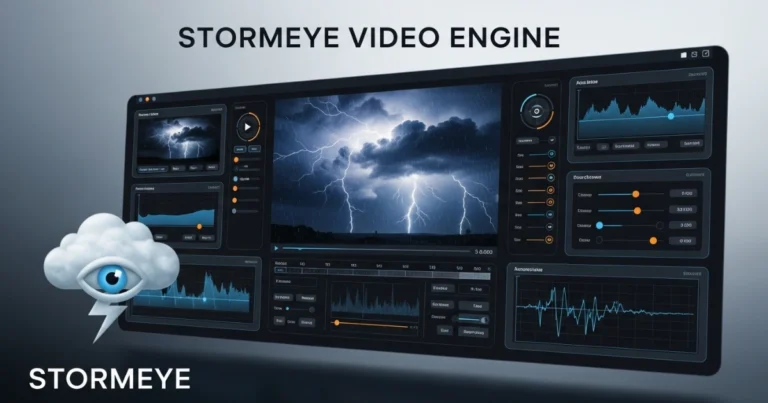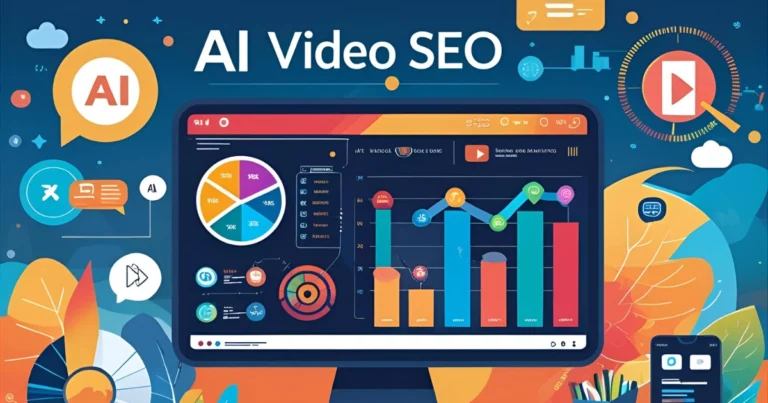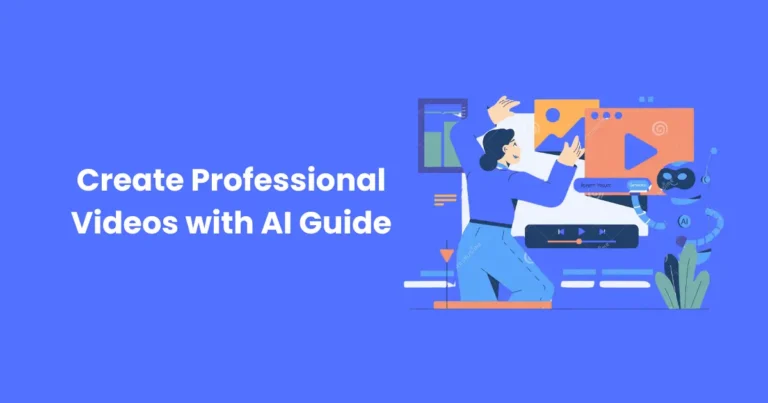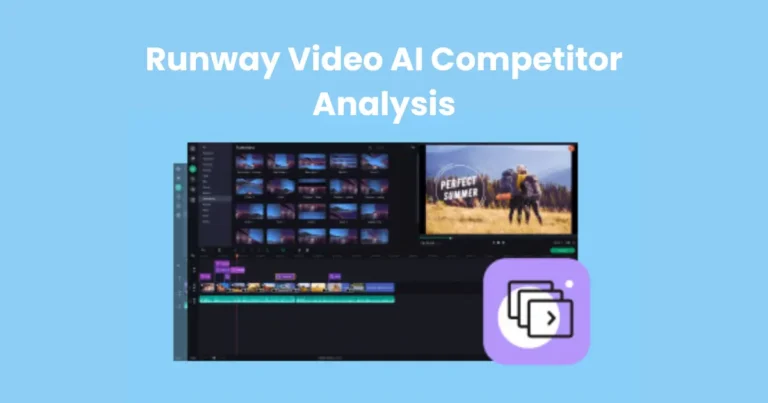AI Video Enhancers | Best AI Video Enhancers on the Market
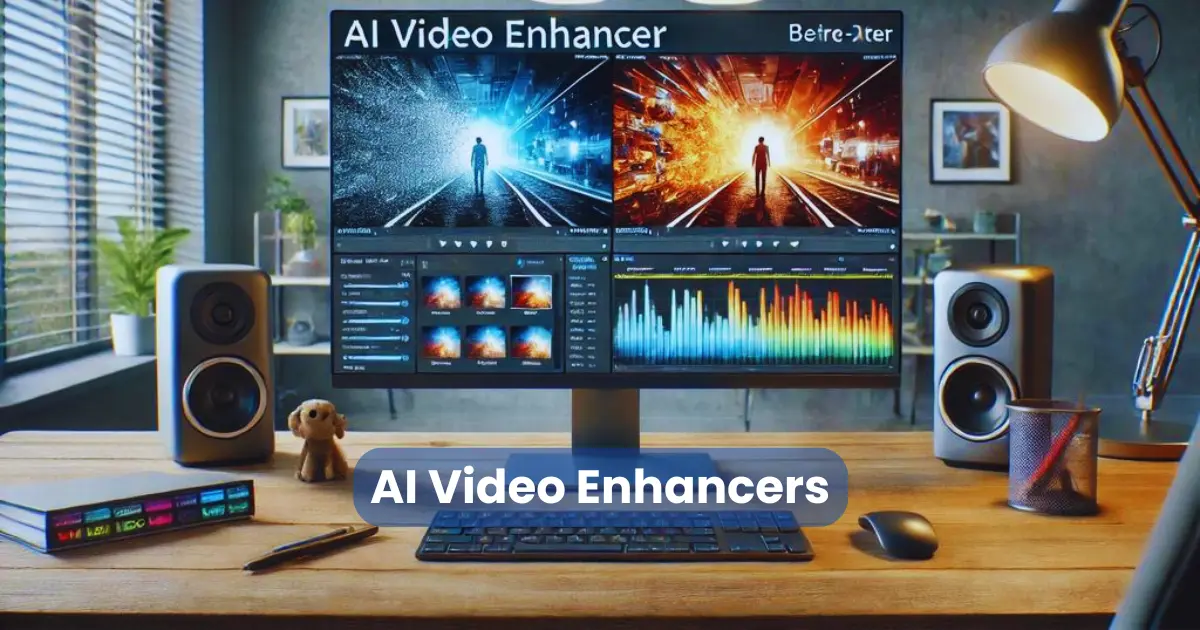
Contents
- 1 What Are AI Video Enhancers?
- 2 How Do AI Video Enhancers Work?
- 3 Top Features of AI Video Enhancers
- 4 Benefits of Using AI Video Enhancers
- 5 Best AI Video Enhancers on the Market
- 6 Future of AI Video Enhancers
- 6.1 1. Improved AI Algorithms for More Natural Enhancements
- 6.2 2. Real-Time Video Enhancements
- 6.3 3. Increased Automation and Customization
- 6.4 4. Integration with Other AI Technologies
- 6.5 5. Enhanced User Experience and Accessibility
- 6.6 6. Higher Resolutions and More Formats Supported
- 6.7 7. Ethical and Privacy Considerations
- 6.8 8. Integration with Other Creative Software
- 6.9 Conclusion
In today’s digital world, video quality is more important than ever. Whether for content creation, marketing, or personal use, high-quality videos are essential to capture and maintain the audience’s attention. AI video enhancers are revolutionizing the way we enhance video quality. These tools, powered by artificial intelligence, automatically improve videos, making them sharper, clearer, and more visually appealing. From upscaling low-resolution footage to removing noise and correcting colors, AI video enhancers provide a fast and efficient solution for achieving professional-grade video quality. We will dive deep into the world of AI video enhancers, exploring how they work, their benefits, and the top tools available for enhancing your videos.
What Are AI Video Enhancers?
AI video enhancers are advanced software tools that leverage artificial intelligence and machine learning algorithms to automatically improve the quality of video footage. These tools are designed to take low-resolution or poorly shot videos and enhance them to a higher standard, making them appear clearer, sharper, and more vibrant. Unlike traditional video editing software, which often requires manual adjustments, AI video enhancers use automated processes to analyze the video and make the necessary improvements, saving users time and effort.

The core technology behind AI video enhancers involves training deep learning models using vast amounts of high-quality video data. These models can identify patterns and key elements in a video, such as edges, textures, and motion, and then apply enhancements such as upscaling resolution, reducing noise, improving frame rates, and correcting color imbalances.
Ultimately, AI video enhancers are designed to make video enhancement accessible to everyone, whether you’re a professional content creator, a business looking to improve your marketing videos, or a casual user who wants to make personal videos look more polished.
How Do AI Video Enhancers Work?
AI video enhancers operate through sophisticated machine learning algorithms that analyze and process video footage to automatically improve its quality. These tools are powered by deep learning models that have been trained on large datasets of high-resolution videos. This training allows the software to understand the structure of videos and identify areas that can be enhanced. Here’s a step-by-step breakdown of how they work:
- Video Frame Analysis
When you upload a video into an AI video enhancer, the software first analyzes each frame of the video. The AI scans these frames for key details like textures, edges, and overall structure. This step is crucial because it allows the AI to understand the context of the video and determine where improvements can be made. - Upscaling and Resolution Enhancement
One of the primary functions of AI video enhancers is to upscale the resolution of a video. Through AI-based upscaling, the software adds extra pixels to low-resolution videos, making them clearer and sharper. The AI uses predictive algorithms to generate details that were missing from the original footage, effectively increasing the resolution and image quality. - Noise Reduction
AI video enhancers can also detect and remove noise or grain that is often present in low-light or poorly captured footage. By isolating these distortions, the AI can reduce the noise and smooth out the video, providing a cleaner, more professional result. - Color Correction and Enhancement
The AI also analyzes the color profile of the video, adjusting the brightness, contrast, and saturation to make the video more vibrant. In cases of color imbalance or poor lighting, the AI can correct these issues, ensuring the colors are more accurate and lifelike.
Top Features of AI Video Enhancers
AI video enhancers come packed with a range of features that help improve video quality automatically and efficiently. These tools utilize advanced machine learning algorithms to handle various aspects of video enhancement, allowing users to achieve professional-quality results without extensive editing knowledge. Below are some of the top features of AI video enhancers:

1. Image Upscaling
One of the most notable features of AI video enhancers is their ability to upscale video resolution. When you work with low-resolution footage, these tools can enhance the image quality by adding more pixels, making the video appear sharper and more detailed. AI-powered upscaling uses deep learning models to predict and recreate finer details that were missing from the original video. This is particularly helpful when working with older videos or footage recorded on lower-quality cameras.
2. Frame Rate Enhancement
AI video enhancers can automatically improve the frame rate of a video, which is essential for smooth motion. If the video was shot at a lower frame rate or appears choppy, AI algorithms can interpolate additional frames to create smoother transitions between frames. This results in fluid, seamless motion, making videos look more professional, especially in high-action scenes or slow-motion footage.
3. Noise Reduction
In videos shot under low light conditions or with lower-quality cameras, noise (grainy pixels or distortion) can be a significant issue. AI video enhancers excel at reducing this noise by detecting the areas of the video affected by grain or blur and then smoothing them out. This results in a cleaner, more polished video without sacrificing important details. The AI can distinguish between noise and fine textures, ensuring that the video retains its quality while eliminating unwanted distortions.
4. Color Correction and Enhancement
Color accuracy is vital for creating visually stunning videos, and AI video enhancers are equipped to automatically correct and enhance color. These tools can adjust the brightness, contrast, saturation, and hues to ensure the video’s colors are vibrant, true-to-life, and visually appealing. The AI can also balance the lighting and shadows, making the video look more natural even if it was originally filmed under poor lighting conditions.
5. Upscaling for Video Formats
Another key feature of AI video enhancers is their ability to upscale videos for different formats. Whether you need to optimize a video for social media, television, or cinema, these enhancers can resize and reformat videos to meet specific requirements without compromising on visual quality. The AI analyzes the content and adjusts it for the best viewing experience across various platforms.
6. Speed and Real-Time Processing
AI video enhancers are designed to provide fast, real-time video processing. Unlike traditional editing software that requires extensive manual intervention and time, AI video enhancers streamline the enhancement process. This feature saves users considerable time, making it ideal for individuals or businesses that need quick results. You can apply enhancements in minutes rather than hours, especially when working with large video files.
7. Automated Enhancements
One of the biggest advantages of AI video enhancers is automation. The AI can automatically identify which areas of the video need enhancement, whether it’s the resolution, noise reduction, or color correction. This minimizes the need for manual adjustments, making the software extremely user-friendly. Even those with little to no video editing experience can achieve professional-quality results with minimal effort.
8. AI-Based Restoration
For older videos or those that have deteriorated over time, AI video enhancers can perform restoration tasks. The AI can repair damaged frames, reduce pixelation, and even reconstruct missing elements, providing a new life to outdated or poor-quality footage. This is particularly useful for archiving old videos, documentaries, or family memories.
Benefits of Using AI Video Enhancers
AI video enhancers offer a wide array of benefits that make them an invaluable tool for content creators, businesses, and casual users alike. By leveraging artificial intelligence, these tools provide an efficient, automated way to enhance video quality without requiring extensive technical knowledge. Below are some of the key benefits of using AI video enhancers:

1. Time Efficiency
One of the biggest advantages of AI video enhancers is the amount of time they save. Traditional video editing processes often require manual adjustments, which can be time-consuming and require expertise. With AI video enhancers, most enhancements are automated, allowing users to achieve professional-quality results in a fraction of the time. The tools process videos quickly and efficiently, making them ideal for situations where time is of the essence, such as tight deadlines or large-scale video production projects.
2. Cost-Effective
Hiring professional video editors or purchasing expensive video enhancement software can be costly. AI video enhancers provide a more affordable alternative by offering automated, high-quality improvements without the need for expensive equipment or services. For small businesses or individual content creators, these tools can drastically reduce costs while still producing top-notch videos.
3. Accessibility for Non-Experts
AI video enhancers are designed to be user-friendly, making them accessible even for those with no video editing experience. You don’t need to be a professional editor to improve the quality of your videos—simply upload your footage and let the AI take care of the rest. This is especially beneficial for content creators, marketers, or business owners who need to enhance videos but lack technical expertise in video production.
4. Improved Video Quality
The primary benefit of AI video enhancers is their ability to automatically improve the quality of videos. Whether you’re working with low-resolution footage, noisy audio, or poor lighting, AI-powered tools can enhance the video’s resolution, reduce noise, correct colors, and ensure smoother motion. The result is a more polished, professional video that captures and holds the audience’s attention.
5. Consistent Results
Because AI video enhancers rely on advanced algorithms, they can deliver consistent results across different types of videos. Whether you’re working on a high-action sequence, a documentary, or a marketing video, the AI ensures that the quality is enhanced uniformly throughout the footage. This level of consistency is difficult to achieve manually, especially when working with large batches of videos or complex projects.
6. Scalability
AI video enhancers are scalable, which means they can handle both small and large video projects with ease. Whether you’re enhancing a single video or processing hundreds of hours of footage, these tools are built to handle large-scale tasks. This scalability makes them suitable for a wide range of industries, from film production and marketing to e-commerce and education.
7. Restores Old or Damaged Videos
AI video enhancers are particularly beneficial for restoring old or damaged footage. Through advanced AI algorithms, these tools can repair pixelated, blurry, or low-quality videos by reconstructing missing data and removing distortions. This is especially useful for preserving family videos, historical archives, or older films that need restoration while maintaining their original charm.
8. Enhanced Marketing and Branding
For businesses and content creators, high-quality videos are a critical part of marketing and branding. AI video enhancers help enhance the visual appeal of promotional videos, product demos, social media content, and advertisements. By improving video quality, you can create more engaging content that resonates with your audience, thereby improving your brand image and increasing viewer retention.
9. Customizable Features
Many AI video enhancers offer customizable features that allow users to tailor enhancements based on their specific needs. Whether you need to adjust the resolution, improve colors, or upscale videos for a specific platform, these tools provide flexibility to suit different requirements. Customization options ensure that the final product meets your desired specifications and delivers the best possible quality for your audience.
10. Works Across Various Platforms
Whether you’re creating content for YouTube, Instagram, corporate presentations, or films, AI video enhancers are versatile enough to support various video formats and platforms. They automatically adapt the video to meet the resolution, aspect ratio, and quality standards of each platform, ensuring your content looks great no matter where it’s displayed.
Best AI Video Enhancers on the Market
There are several AI video enhancers available today, each offering unique features and capabilities to suit different needs. Whether you’re a content creator, business, or casual user, the following tools stand out for their effectiveness in improving video quality, ease of use, and powerful AI-driven enhancements.

1. Topaz Video Enhance AI
Topaz Video Enhance AI is one of the most popular and powerful AI video enhancers available. It leverages deep learning algorithms to upscale low-resolution videos, reduce noise, and enhance detail. The software can increase video resolution up to 8K, making it perfect for high-quality production.
- Key Features:
- Upscales video up to 8K resolution.
- Reduces noise and artifacts.
- Enhances video detail and sharpness.
- Supports a wide range of video formats.
- Provides a user-friendly interface for beginners and professionals.
- Best For: Content creators, filmmakers, and anyone who needs to upscale videos with high-quality results.
2. DVDFab Enlarger AI
DVDFab Enlarger AI is an excellent choice for anyone looking to upscale video resolution. The tool uses AI to increase video quality by up to 300%, enhancing details, colors, and overall visual appeal.
- Key Features:
- Upscales videos by 300% (e.g., from 480p to 1080p).
- Enhances video resolution without losing details.
- Works well with both 2D and 3D videos.
- Easy to use with a simple interface.
- Best For: Users who want an easy-to-use tool to upscale videos for personal or professional use.
3. HitPaw Video Enhancer
HitPaw Video Enhancer is another powerful AI video enhancer that focuses on improving video quality through AI-driven technology. The software can upscale videos, reduce noise, and adjust colors for enhanced visual output.
- Key Features:
- Upscales videos with AI to improve resolution.
- Offers noise reduction to eliminate grain and distortion.
- Improves video quality in real-time.
- Intuitive interface with one-click enhancements.
- Best For: Beginners or users who prefer an easy-to-use solution with powerful AI capabilities.
4. Waifu2x
Waifu2x is an AI-powered video enhancer specifically designed to improve anime or cartoon-style videos. It uses deep convolutional neural networks to upscale and denoise images and videos with remarkable results. While it’s popular for anime, it can also work well for other types of videos.
- Key Features:
- Specializes in anime-style video upscaling.
- Reduces noise and enhances fine details.
- Free to use for most basic features.
- Works with still images and videos.
- Best For: Anime content creators or anyone working with animated video footage.
5. Aiseesoft Video Enhancer
Aiseesoft Video Enhancer offers a robust suite of AI-powered tools designed to upscale videos, enhance brightness and contrast, and remove unwanted noise. The software allows for quick video enhancement with minimal effort, making it a great option for both personal and professional use.
- Key Features:
- Upscales video resolution.
- Improves video brightness, contrast, and saturation.
- Reduces noise in video footage.
- Batch processing for multiple videos at once.
- Best For: Users who need a comprehensive tool for video quality enhancement and batch processing.
6. Veed.io
Veed.io is an online video editor with built-in AI tools to enhance video quality. While it’s known for its intuitive editing platform, it also offers AI-based features like auto-subtitle generation and video enhancement.
- Key Features:
- Offers AI tools for improving video clarity and quality.
- Cloud-based, so no installation required.
- AI-driven noise reduction and image enhancement.
- Online tool with easy accessibility.
- Best For: Users who want to enhance videos directly in a browser without needing to download heavy software.
7. VideoProc Vlogger
VideoProc Vlogger is an AI video editor that focuses on enhancing video quality through various features, including AI-driven noise reduction, resolution upscaling, and video stabilization. It provides a seamless editing experience for creators who need quick fixes for video quality issues.
- Key Features:
- AI-powered video noise reduction and enhancement.
- Real-time video editing and processing.
- Upscales videos and stabilizes shaky footage.
- Supports all major video formats.
- Best For: Video creators who want an all-in-one tool for editing and enhancing video quality with AI.
Future of AI Video Enhancers
The future of AI video enhancers looks incredibly promising, with rapid advancements in artificial intelligence, machine learning, and deep learning technologies. As these tools continue to evolve, they will become more sophisticated, offering enhanced capabilities, increased automation, and broader applications. Here are some key trends and developments to watch for in the future of AI video enhancers:

1. Improved AI Algorithms for More Natural Enhancements
As AI models continue to improve, we can expect even more natural and accurate video enhancements. Currently, many AI video enhancers focus on basic tasks such as upscaling resolution, noise reduction, and sharpness enhancement. In the future, AI will likely evolve to produce results that closely mirror human intuition, such as:
- More realistic color grading and adjustments.
- Enhanced lighting and shadows, creating a more cinematic look.
- Better preservation of video detail while upscaling, avoiding distortion or “over-enhancement.”
These improvements will allow creators to produce higher-quality content with minimal effort and time spent on manual editing.
2. Real-Time Video Enhancements
One of the most exciting developments in the future of AI video enhancers is the potential for real-time video processing. Today, high-quality video enhancement often requires significant time to process, particularly with high-resolution videos or long footage. In the future, AI could enable real-time enhancements, making it possible to:
- Upscale videos during live streaming or recording.
- Automatically enhance videos as they are being captured, providing immediate feedback.
- Perform real-time noise reduction and stabilization during live broadcasts or video conferencing.
This would revolutionize industries like live streaming, remote work, and online education by ensuring high-quality visuals without the need for post-production.
3. Increased Automation and Customization
While many AI video enhancers are already user-friendly, the future will bring even more advanced automation and customization options. Future AI video enhancement tools will likely:
- Automatically detect video issues, such as low resolution, noise, or blurriness, and apply suitable enhancements.
- Customize enhancements based on the content of the video, such as applying different enhancements to animated videos versus live-action footage.
- Provide users with personalized settings, using AI to learn their preferences and apply enhancements tailored to their specific needs.
These advancements will make it easier for creators to produce high-quality videos without the need for extensive knowledge of video editing techniques.
4. Integration with Other AI Technologies
The future of AI video enhancers will see deeper integration with other AI-driven technologies, further expanding their capabilities. For instance:
- AI-based speech recognition will allow video enhancers to synchronize voice and audio, ensuring clearer audio quality along with visual enhancements.
- AI-driven facial recognition will enable more precise enhancement of human subjects in videos, improving facial details, expressions, and clarity.
- Motion tracking and stabilization powered by AI will allow video enhancers to automatically correct shaky footage and enhance motion in dynamic scenes.
These integrations will streamline the entire video enhancement process, offering a more holistic approach to video production.
5. Enhanced User Experience and Accessibility
As AI technology becomes more accessible, AI video enhancers will become available to a broader audience. With increased accessibility, we can expect:
- More affordable or freemium options, making it easier for small businesses, independent creators, and casual users to access advanced video enhancement features.
- Cloud-based AI video enhancement tools that allow users to enhance videos without the need for powerful hardware or extensive storage space.
- Simplified interfaces with AI-driven presets and automatic recommendations, making video enhancement accessible to individuals with no prior video editing experience.
These improvements will democratize high-quality video enhancement, empowering creators of all backgrounds to improve their content.
6. Higher Resolutions and More Formats Supported
The demand for high-resolution content, including 4K and 8K videos, will continue to rise. Future AI video enhancers will be equipped to handle even higher resolutions and a wider variety of formats:
- Support for 8K video enhancement and beyond.
- Enhanced upscaling for non-traditional formats, such as virtual reality (VR) or augmented reality (AR) content.
- Better handling of ultra-wide aspect ratios and unconventional video formats, ensuring high-quality enhancements across all types of content.
These advancements will make AI video enhancers suitable for cutting-edge applications in areas like virtual reality, gaming, and professional film production.
7. Ethical and Privacy Considerations
As AI continues to play a significant role in video enhancement, there will be growing concerns about ethics and privacy. AI video enhancers have the potential to be used for creating deepfakes or altering videos in ways that may mislead audiences. In the future, the development of ethical guidelines and regulatory measures will likely become crucial to ensure responsible use of AI video enhancement technologies:
- Developers may implement AI-based watermarking or authenticity verification tools to help identify altered content.
- There will be increased focus on transparency, with users able to understand how AI models process and alter their videos.
- Collaboration between tech companies and policymakers will ensure that AI video enhancement tools are used responsibly and ethically.
8. Integration with Other Creative Software
As AI video enhancement becomes more mainstream, there will be deeper integration with other creative software tools, such as video editing programs, motion graphics software, and animation platforms. This integration will make it easier for creators to apply AI-driven enhancements alongside traditional editing techniques. Key benefits will include:
- Seamless workflows that allow users to enhance videos without switching between multiple software programs.
- AI-enhanced templates and presets that speed up the editing process.
- Increased collaboration between AI-driven video tools and traditional creative software.
Conclusion
The future of AI video enhancers holds immense promise, with continuous advancements that will significantly improve how video content is created, edited, and enhanced. From the ability to upscale resolutions in real-time to offering smarter, more intuitive automation, these tools are set to revolutionize the video production process across industries. As AI continues to evolve, expect even greater accuracy in enhancements, enhanced customization options, and more seamless integration with other creative technologies.
With AI-driven video enhancements becoming more accessible, affordable, and user-friendly, creators—from hobbyists to professionals—will have the power to produce high-quality video content with minimal effort. However, as the technology becomes more widespread, the need for ethical guidelines and privacy protections will grow to ensure AI tools are used responsibly.
In the coming years, AI video enhancers will not only streamline workflows and improve content quality but also empower creators to push the boundaries of their work. As this technology develops, it will open up new creative possibilities and continue to shape the future of video production.

